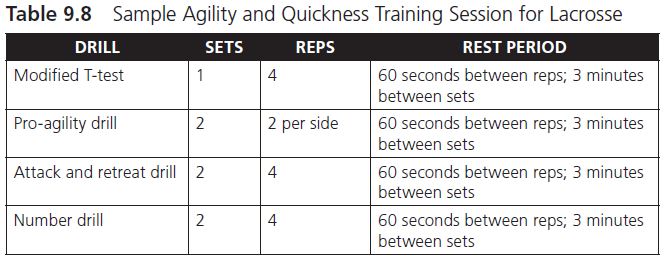Lacrosse
by Developing Agility and Quickness
Kinetic Select
February 2021
This excerpt briefly explains programming agility sessions for lacrosse athletes.
The following is an exclusive excerpt from the book Developing Agility and Quickness, Second Edition, published by Human Kinetics. All text and images provided by Human Kinetics.
Like ice hockey, lacrosse is considered to be an invasion sport, with one team trying to penetrate another team’s domain (1). Although lacrosse is played on a relatively large open field (120 yards [109.7 m] × 60 yards [54.9 m]), the majority of the 60-minute game is played six-on-six in a space of 60 yards (54.9 m) × 60 yards (54.9 m). Because the field of play is so short, agility is a critical skill for the success of the lacrosse athlete (2).
Lacrosse is a game that involves exposure to intermittent high-intensity activity, collisions, and COD, and requires components of both open and reactive agility (2). In lacrosse, agility requires the athlete to accelerate and decelerate linearly on a repeated, almost continuous, basis in multiple directions at varying speeds and intensities (1).
It is beneficial for the athlete to perform agility drills while holding a lacrosse stick. Lacrosse requires catching and throwing and also ball control by cradling. Incorporating these skills during agility training may be useful after the athlete has demonstrated good form and technique without a stick. These simulated stick skills should be position-specific for the athlete. For example, during the attack and retreat drill, the defensive athlete should spoke check and attack, while midfielders should hand check at the same time as footwork is practiced. As the athletes become more efficient, have them cradle the ball while doing the drills and be sure they work on both strong- and weak-side cradling.
Program Design
Many of the drills featured in chapters 6 and 7, both specific and general movement, can be easily applied to the game of lacrosse. The complexity of the training drills should be appropriate to the athlete’s skill level and tactical maturity. The agility program should begin with learning basic agility patterns (e.g., acceleration, deceleration, cutting, running) before progressing to drills that are more lacrosse-specific.
Coaches can improve their athletes’ reactive agility by incorporating cognitive aspects into the training drills to enhance their perceptual and decision-making skills (3) to better evaluate their circumstances, analyze the information, decide on what actions need to be deployed, and then perform the movements or actions to be successful. This can be accomplished in several ways.
- Add a reactive component by incorporating an auditory or visual stimulus that signifies a specific COD or a technical skill (e.g., sprinting, lateral shuffle, backpedal).
- Incorporate stick skills while performing the agility drill. These skills may include catching, throwing, and cradling. Incorporating ball handling skills with the stick increases the athletes’ cognitive load because, in doing so, they must be attentive to the specific skills required to handle the stick, as well as executing proper movements within the drill. This is similar to what the athletes will be required to do in their sport.
- Have the athlete perform a simple math calculation while performing an agility drill to increase the cognitive workload and require the athlete to process the information quickly and respond accurately. For some examples, refer to the program design section for ice hockey (page 198).
Generally speaking, decision-making tasks within agility drills should progress from simple to more complex. Athletes should perform the drills without an implement (i.e., a stick) initially so they can focus on the proper footwork patterns and movements needed to execute the agility task. Once the athlete demonstrates basic movement proficiency in these drills, a lacrosse stick can be added. Finally, ball handling and catch and throw activities can be added for the most advanced level of both physical and mental agility for lacrosse. If a coach detects that an athlete cannot correctly execute a task, the cognitive load needs to be simplified or removed until the athlete can consistently perform the task correctly.
When designing an agility session, the coach should start the athletes with small-space drills and then progress to larger-space drills. The small-space drills require multiple quick CODs, which places a higher demand on the central nervous system than larger-space drills because of spatial and temporal constraints (3). It is also more effective to perform these drills while the central nervous system is not fatigued to ensure that technique is not significantly impaired.
Table 9.8 provides a sample training session for lacrosse.

- Privacy Policy
- Your Privacy Choices
- Terms of Use
- Retraction and Correction Policy
- © 2025 National Strength and Conditioning Association